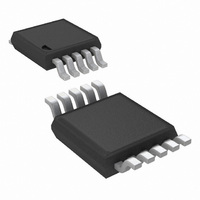LM3445MM/NOPB National Semiconductor, LM3445MM/NOPB Datasheet - Page 11

LM3445MM/NOPB
Manufacturer Part Number
LM3445MM/NOPB
Description
IC LED DRIVER TRIAC DIMM 10-MSOP
Manufacturer
National Semiconductor
Series
PowerWise®r
Type
Triac Dimmabler
Specifications of LM3445MM/NOPB
Mfg Application Notes
LM3445 Reference Design
Constant Current
Yes
Topology
PWM, Step-Down (Buck)
Number Of Outputs
1
Internal Driver
No
Type - Secondary
High Brightness LED (HBLED)
Frequency
30kHz ~ 1MHz
Voltage - Supply
8 V ~ 12 V
Mounting Type
Surface Mount
Package / Case
10-MSOP, Micro10™, 10-uMAX, 10-uSOP
Operating Temperature
-40°C ~ 125°C
Current - Output / Channel
1A
Internal Switch(s)
Yes
Efficiency
85%
For Use With
LM3445-220VEVAL - BOARD EVAL LM3445 220VLM3445-120VSMEV - BOARD EVAL LM3445 110VLM3445TRIACEVAL - BOARD EVAL LM3445MM
Lead Free Status / RoHS Status
Lead free / RoHS Compliant
Voltage - Output
-
Other names
LM3445MMTR
Available stocks
Company
Part Number
Manufacturer
Quantity
Price
Company:
Part Number:
LM3445MM/NOPB
Manufacturer:
TI
Quantity:
7 000
performance vs efficiency. As the holding resistor R5 is in-
creased, the overall efficiency per LM3445 will also increase.
ANGLE DETECT
The Angle Detect circuit uses a comparator with a fixed
threshold voltage of 7.21V to monitor the BLDR pin to deter-
mine whether the triac is on or off. The output of the com-
parator drives the ASNS buffer and also controls the Bleeder
circuit. A 4 µs delay line on the output is used to filter out noise
that could be present on this signal.
The output of the Angle Detect circuit is limited to a 0V to 4.0V
swing by the buffer and presented to the ASNS pin. R1 and
C3 comprise a low-pass filter with a bandwidth on the order
of 1.0Hz.
The Angle Detect circuit and its filter produce a DC level which
corresponds to the duty cycle (relative on-time) of the triac
dimmer. As a result, the LM3445 will work equally well with
50Hz or 60Hz line voltages.
BLEEDER
While the BLDR pin is below the 7.21V threshold, the bleeder
MOSFET is on to place a small load (230Ω) on the series pass
regulator. This additional load is necessary to complete the
circuit through the triac dimmer so that the dimmer delay cir-
cuit can operate correctly. Above 7.21V, the bleeder resistor
is removed to increase efficiency.
FLTR1 PIN
The FLTR1 pin has two functions. Normally, it is fed by ASNS
through filter components R1 and C3 and drives the dim de-
coder. However, if the FLTR1 pin is tied above 4.9V (typical),
e.g., to VCC, the Ramp Comparator is tri-stated, disabling the
dim decoder. See the Master/Slave section.
DIM DECODER
The ramp generator produces a 5.85 kHz saw tooth wave with
a minimum of 1.0V and a maximum of 3.0V. The filtered ASNS
signal enters pin FLTR1 where it is compared against the
output of the Ramp Generator.
The output of the ramp comparator will have an on-time which
is inversely proportional to the average voltage level at pin
FLTR1. However, since the FLTR1 signal can vary between
0V and 4.0V (the limits of the ASNS pin), and the Ramp Gen-
erator signal only varies between 1.0V and 3.0V, the output
of the ramp comparator will be on continuously for V
1.0V and off continuously for V
coding range from 45° to 135° to provide a 0 – 100% dimming
range.
FLTR1
> 3.0V. This allows a de-
FIGURE 8. Two and Three Stage Valley Fill Circuit
FLTR1
<
11
The output of the ramp comparator drives both a common-
source N-channel MOSFET through a Schmitt trigger and the
DIM pin (see the Master/Slave section for further functions of
the DIM pin). The MOSFET drain is pulled up to 750 mV by a
50 kΩ resistor.
Since the MOSFET inverts the output of the ramp comparator,
the drain voltage of the MOSFET is proportional to the duty
cycle of the line voltage that comes through the triac dimmer.
The amplitude of the ramp generator causes this proportion-
ality to "hard limit" for duty cycles above 75% and below 25%.
The MOSFET drain signal next passes through an RC filter
comprised of an internal 370 kΩ resistor, and an external ca-
pacitor on pin FLTR2. This forms a second low pass filter to
further reduce the ripple in this signal, which is used as a ref-
erence by the PWM comparator. This RC filter is generally set
to 10Hz.
The net effect is that the output of the dim decoder is a DC
voltage whose amplitude varies from near 0V to 750 mV as
the duty cycle of the dimmer varies from 25% to 75%. This
corresponds to conduction angles of 45° to 135°, respectively.
The output voltage of the Dim Decoder directly controls the
peak current that will be delivered by Q2 during its on-time.
See the Buck Converter section for details.
As the triac fires beyond 135°, the DIM decoder no longer
controls the dimming. At this point the LEDs will dim gradually
for one of two reasons:
1.
2.
The transition from dimming with the DIM decoder to head-
room or minimum on-time dimming is seamless. LED currents
from full load to as low as 0.5 mA can be easily achieved.
VALLEY-FILL CIRCUIT
V
D3 allows V
V
the voltage ripple when the valley fill capacitors are being
charged. However, the network of diodes and capacitors
shown between D3 and C10 make up a "valley-fill" circuit. The
valley-fill circuit can be configured with two or three stages.
The most common configuration is two stages. Figure 8 illus-
trates a two and three stage valley-fill circuit.
BUCK
BUCK
The voltage at V
runs out of headroom and causes LED current to
decrease as V
Minimum on-time is reached which fixes the duty-cycle
and therefore reduces the voltage at V
has a relatively small hold capacitor C10 which reduces
supplies the power which drives the LED string. Diode
BUCK
to remain high while V+ cycles on and off.
BUCK
BUCK
decreases.
decreases and the buck converter
BUCK
.
www.national.com
30060318













